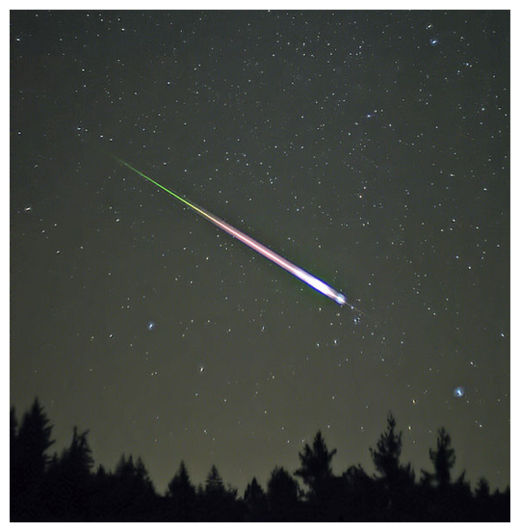
© Wikimedia Commons
It might have been the size of a pea, or maybe as big as a football. Still, streaking across the Boulder skies late Tuesday night, it made quite an impression on those who saw it.
Trevor Ycas, who lives in the Martin Acres neighborhood, was lounging in the backyard with four friends around 11 p.m. when they saw what he said was a meteor. They watched, said Ycas, as it split into four distinct pieces.
"It was going south to north, so I think it broke up somewhere north of Loveland, or maybe Greeley. I used a compass to check the trajectory, and I think it was about 15 to 20 degrees east of north," Ycas said.
Several in Ycas's group attempted to film it with camera phones, but were unsuccessful in capturing good images. But the time stamp from those attempts show that it occurred about 10:34 p.m., Ycas said.
There were plenty of other witnesses as well, including some who were out under the stars at Red Rocks Amphitheater for Film on the Rocks. "Meteor so large the crowd at Film on the Rocks was cheering," tweeted one.
Seth Hornstein, director of the Sommers-Bausch Observatory at the University of Colorado and a professor in the Department of Astrophysical & Planetary Sciences, had not heard about the sighting until contacted by the Camera.
"It was probably a lone meteor," said Hornstein. "There's no showers coming up - the Persieds were in August, and the Orionids are the next ones in mid-October. It was probably just a stray."
Hornstein said a CU professor and graduate student were manning the telescope at Sommers-Bausch Observatory from about 8:30 p.m. to 9:30 p.m., but were not watching the skies when the meteor passed over.
Fabio Mezzalira, manager of the Sommers-Bausch Observatory, said he saw what he thought was two meteors in the northern portion of the sky, at about 10:30 p.m., "none of which seemed particularly spectacular. There is a good chance I missed the one you're talking about."
Mezzalira said the observatory is equipped with an all-sky camera that can record transient events such as meteors, but due to some ongoing construction projects, it is not currently turned on.
"Typically these things are the size of grains of sand and small peas, unless it created a boom, in which it would be slightly larger," Hornstein said. "Typically, the ones that are really bright might be the size of peas," that dissipate their energy as they passes through the atmosphere making them more discernible naked eye.
Ycas said his father is an amateur astronomer, and he describes himself as an "avid night sky observer." He has been known to often sleep outside specifically to watch the skies. He said he has seen many meteors before.
"It lasted for almost 12 seconds, and it turned into a fireball and started leaving like a long orange-yellow gaseous trail, as it started to combust in our atmosphere, and we saw it break into at least four pieces," he said.
"My guess, just based on amateur knowledge, is that it was the size of a football," Ycas said. "It can't have been much larger than that. And the fact that it didn't leave a sonic boom means it still had to be in the upper atmosphere. You can't get a sonic boom in the upper atmosphere."

Reader Comments
to our Newsletter